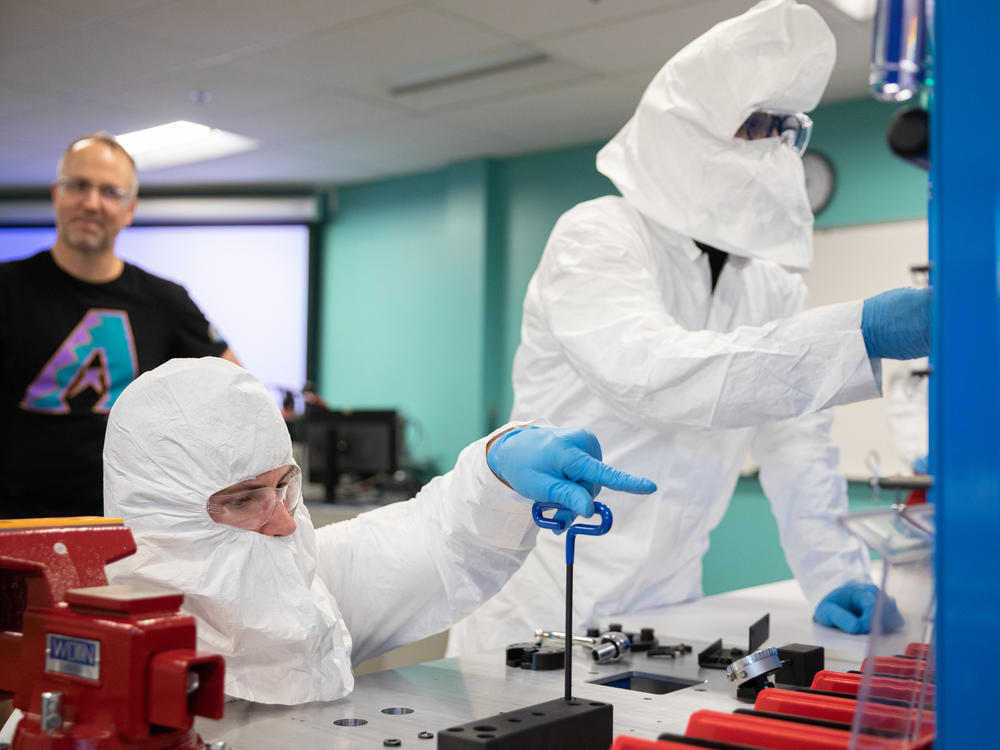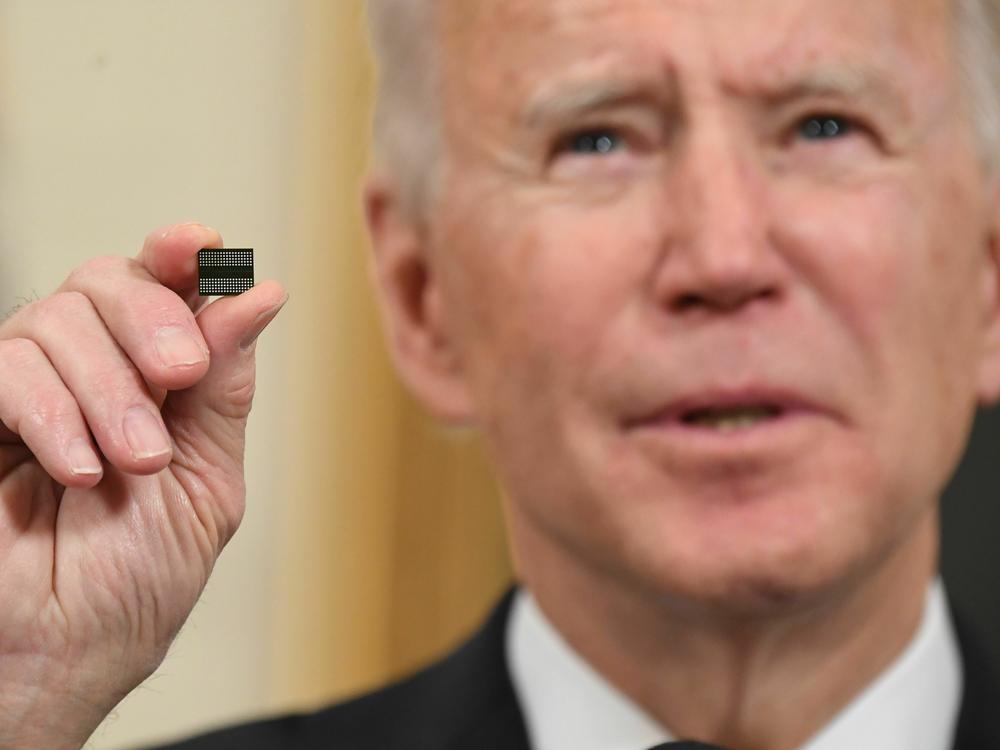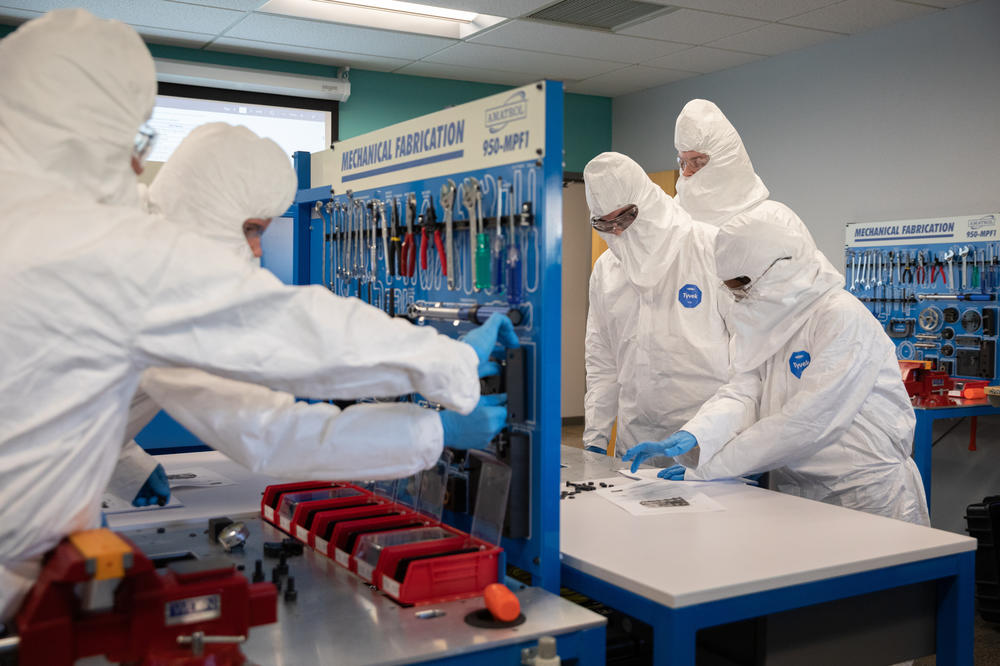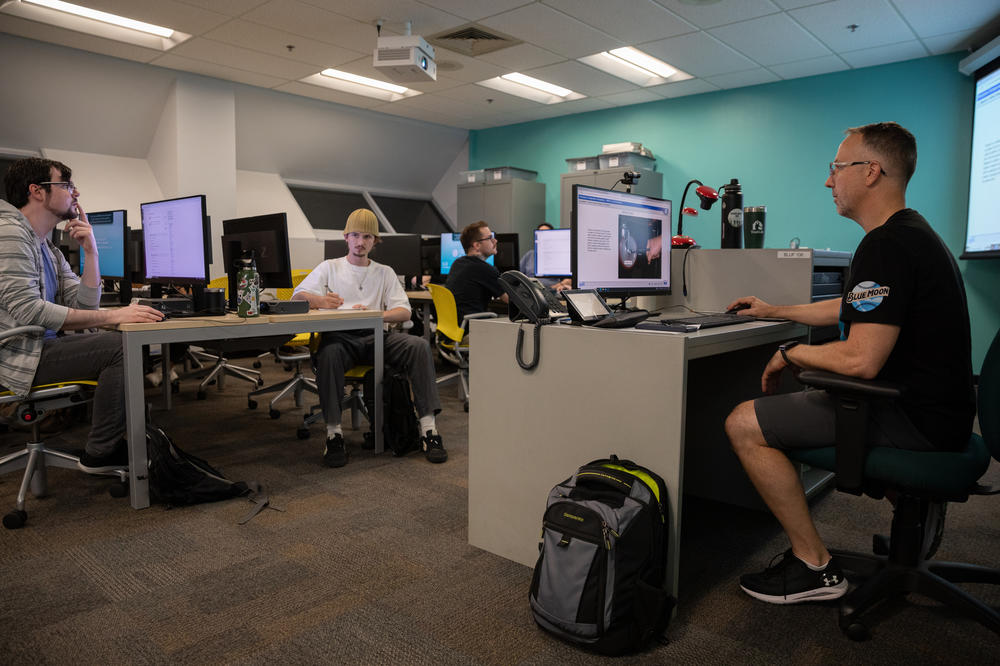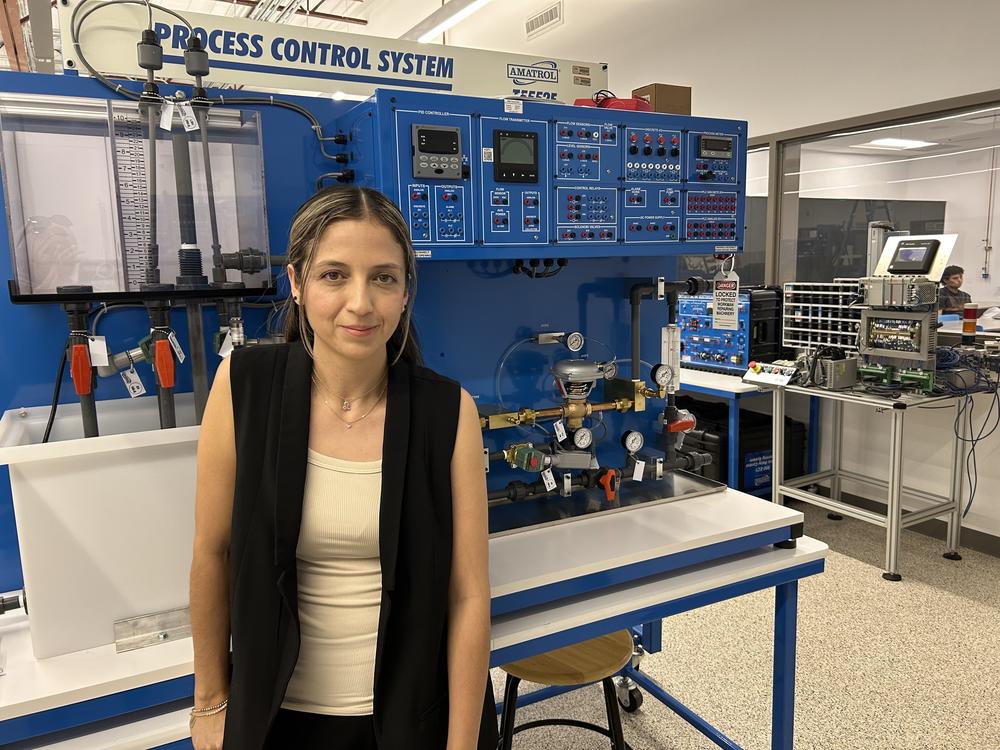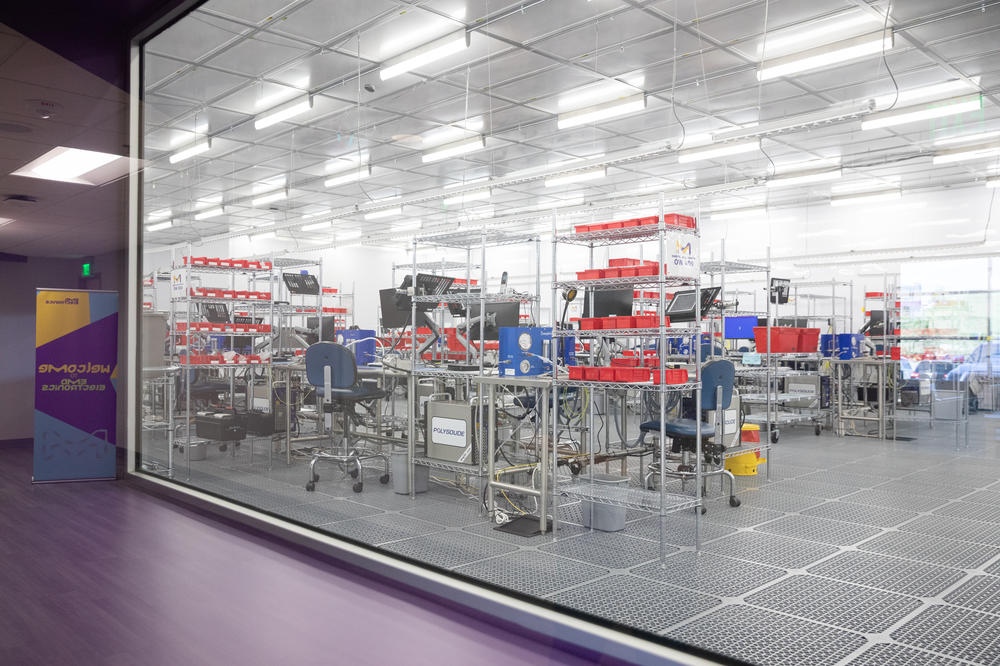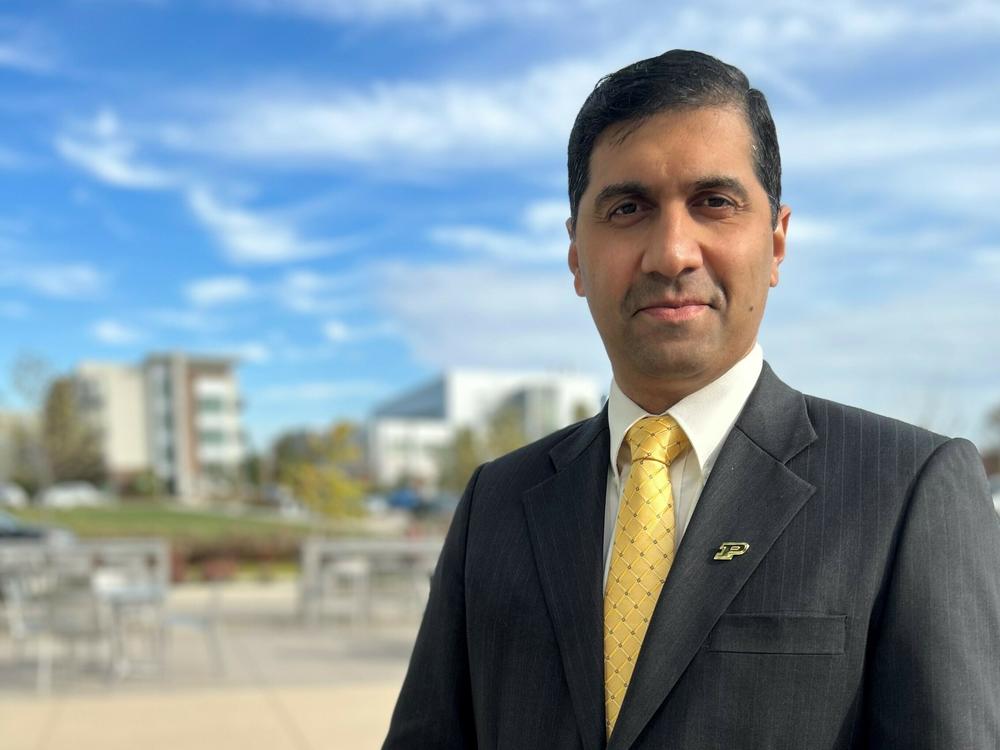Section Branding
Header Content
Biden has big plans for semiconductors. But there's a big hole: not enough workers
Primary Content
Liam Levinson spent the past few years working in restaurant kitchens where he says "they work you to the bone" for not enough pay. So, when the 28-year-old came across an article in a tech magazine about a potential boom in Arizona semiconductor jobs, he was intrigued.
"It involves two elements I'm very comfortable with," said Levinson. "I'm very tech savvy and I've also been in the restaurant industry, which is just hands-on work for long periods of time."
So, he signed up for a 10-day boot camp at Chandler Gilbert Community College in Mesa, Ariz., a crash course aimed at quickly training thousands of new entry-level semiconductor technicians.
It's one of over 50 community college programs that have sprung up around the nation, responding a boom in the industry connected to President Biden signing the CHIPS and Science Act into law last year.
The goal of the law is to dramatically boost U.S. production of semiconductor chips — the tiny electronic devices found in everything from cars to cell phones to military weapons. The vast majority of chips currently are made in Asia.
The law gives the Biden administration $52.7 billion to pour into semiconductor plants. This month, it rolled out its first investment: $35 million for defense contractor BAE Systems Inc. to expand a semiconductor plant in Nashua, N.H.
These kinds of investments and the jobs they create are a big part of President Biden's economic pitch for his reelection campaign. But there's a major hurdle to turning expansion plans into reality — currently, there are not enough workers to fill those jobs.
"As these big investments come, we need the people," said Shari Liss, executive director of the SEMI Foundation. She oversees the microelectronics industry's efforts to boost workforce development.
"If we don't have the people, that's going to be a huge problem, that's the fear."
Boot camps can help train technicians
To meet the expected demand, the White House says the United States needs 90,000 to 100,000 more semiconductor technicians — and needs to triple the number of engineering grads — by 2030. The engineering shortage could be as high as 300,000 by the end of the decade, according to a report from consulting firm McKinsey & Co.
One attempt to fill the gap is the community college program in Arizona's Maricopa County, where Liam Levinson is learning what it means to be a semiconductor technician.
On the third night of class, teacher Jeff Bruchhauser handed out Tyvek bunny suits — coveralls, gloves, booties, hair nets and safety glasses.
The students handled wrenches and washers, trying to complete group labs, all while wearing these somewhat claustrophobic white space suit-looking outfits.
"It was sweaty," Levinson said, but he took solace in hearing that it's generally cooler in the clean rooms where technicians wear these suits to prevent contamination.
"This is more to give you an idea of what it feels like to be working in the environment with something on your body on top of the clothes you already have," Bruchhauser explained.
Bruchhauser spends his days working as a semiconductor technician at Intel, and his evenings teaching this class to train and create the next generation of semiconductor technicians.
The curriculum was devised with the help of Intel. The college created lessons based on what chip companies said they needed in their job descriptions. To date, roughly 770 students have completed the course. The college did not provide information on what percentage of its graduates are now employed in the semiconductor industry.
Perla Lugo, 34, used the boot camp course to help land a full-time job at Intel. She said she was initially intimidated by the tight 10-day timeline. "I was a little bit scared — I'm like, 'How am I going to get this done in two weeks?'" she said.
A lot of the information, like how to use a compressor and measure voltage, was new to Lugo, who until recently had been a stay-at-home mom of three. But she was enticed by the school's promise that the course was free for students who passed it. "There's a lot of opportunities with [the] technology growing as fast as it is," Lugo said. "I think the future, it's going to be great, but we have a lot to learn still."
The Biden administration is working with industry to boost training
The Biden administration knows that it needs skilled workers to fill the new jobs, and addressing that gap has been at the center of its strategies. As the administration evaluates the requests for funding from semiconductor companies planning expansion projects, one of the factors is how the companies are planning to develop their workforce.
"This is the largest public investment in private industry that we've made in generations," said Mike Schmidt, director of the Biden administration's CHIPS office, a team of about 200 people spanning across four floors of the Commerce Department. "We are building a new muscle for the government."
To this end, the National Science Foundation launched a $45 million investment for 24 semiconductor research and education projects to train semiconductor workers.
The White House also started workforce hubs in Arizona, Ohio, Georgia, Pennsylvania and Maryland to help identify training programs. The hub in Columbus, Ohio, near the site of a major new Intel chip-making facility, led to Columbus State Community College launching a program to boost the number of semiconductor technicians in the region.
"It is no surprise that it's going to be a challenge to build a workforce necessary to really help an industry thrive when what you're talking about doing is changing the trajectory of an industry that has been [in] decline in this country for decades," Schmidt said.
The industry is worried about filling the gap on time
But even with the industry and government focused on the problem, it's not clear the timeline to hire new workers will align with the timeline to train new employees. Some chip executives are anxious they'll be able to find enough workers in time.
"That's the thing that keeps me awake at night," said Alex Oscilowski, with Tokyo Electron, a company that makes equipment used in semiconductor plants.
Finding talent is the biggest challenge his industry faces, he said. "And that challenge is only going to increase as the industry grows because we're growing at a rate faster than our universities are able to produce skilled talent for us," he said.
While companies may be able to train semiconductor technicians quickly through boot camps like the Arizona community college program, they face a much longer lead time when it comes to finding another group of workers they desperately need: highly skilled engineers.
Industry experts, university professors and company executives all want to see more of a focus on science and math education among K-12 students so that students pursue engineering in college. The other challenge for chip companies is that among the small crop of already-existing engineering graduates, they're competing for hires against well-known software and social media companies.
"There's a huge concern right now around, how do we sell this industry to students?" said Liss with the SEMI Foundation.
Students may work on computers or cell phones all day long, but they're not exposed to the chips inside that make the machines run, Liss said.
"Our challenge as an industry is that we are so invisible to potential employees."
There's a huge shortage of engineering grads
Last year, Purdue University in Indiana launched the nation's first program for semiconductor degrees.
"We realized ... that this is a problem that's coming down the pipe. We've got to get ahead of the game," said Vijay Raghunathan, the director of Purdue's program.
The goal was to attract students interested in science who would otherwise pursue other fields: students like 19-year-old Adam Mack.
"When I came to Purdue in the fall of my freshman year, I was originally planning on going into computer engineering," Mack said. "If you asked me what a semiconductor was, I could not have told you. I'd never really heard of the industry before."
But after a summer program introducing him to the field, Mack shifted his focus to semiconductors.
In total, Raghunathan estimates there are about 250 students involved in the university's chips program.
One of them is Humbert Lai, 22, from Taiwan. His goal is to stay in the United States after graduation and work on semiconductor design. But that pathway is complicated by U.S. immigration law, which doesn't make it easy for skilled workers to get visas.
"I feel like it's kind of hard as an international student," Lai said. "If I can't find a job here, I'll have to go back."
Copyright 2023 NPR. To see more, visit https://www.npr.org.
